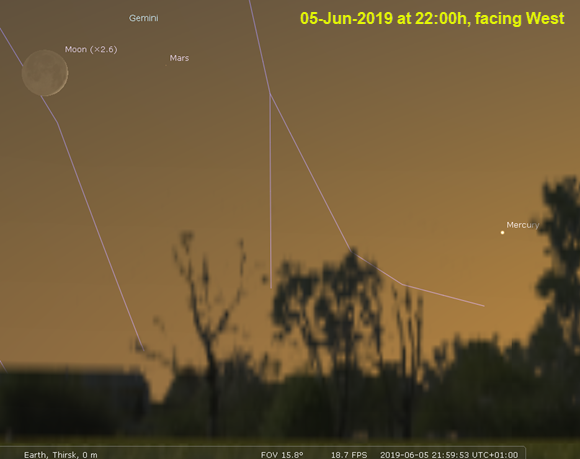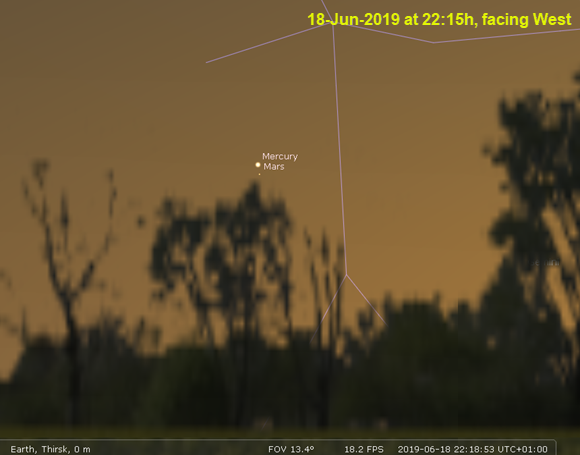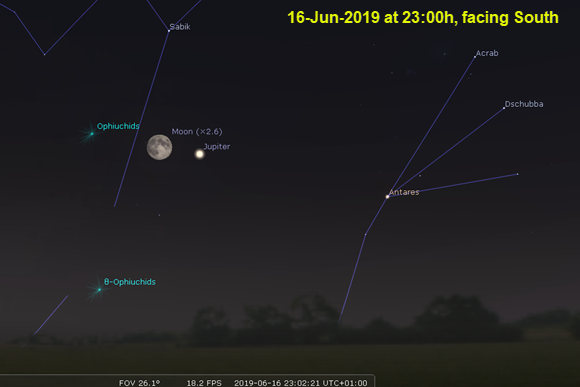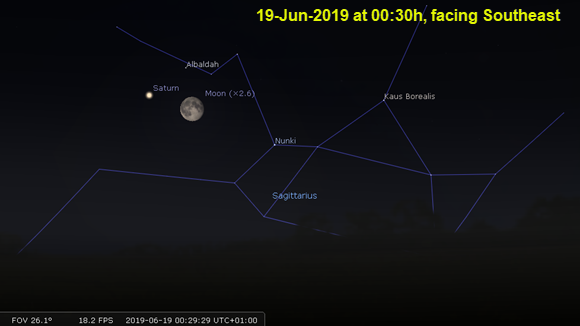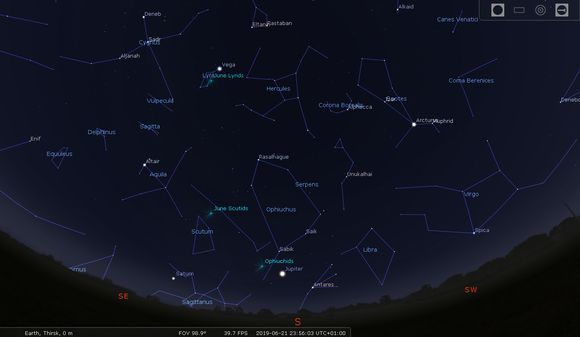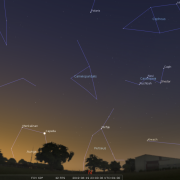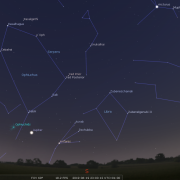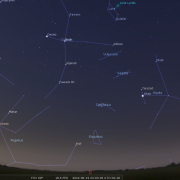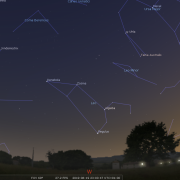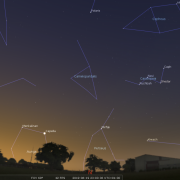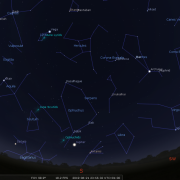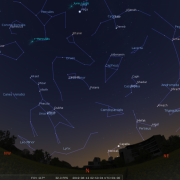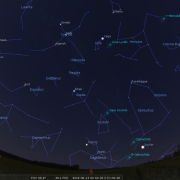Welcome to the WDAS monthly newsletter for June 2019: a digest of the month's latest contributions to our website. Below you'll find Society News; past and coming events; a tour of the Seas and Craters of The Moon; and, of course, Sky Notes including notes on the Summer Solstice and noctilucent cloud.
Society News
After skies cleared quite late for our scheduled star party on the May11th, (and having not erected any placards as a result), we decided to utilise the conditions by trying out the LX 200 and power pack for a pre-season shakedown run.
Keith, John, Phil and Elaine all came up to the college where we hoped to have a good shakedown test of the Meade scope. Initially, things did not look promising, problems with the power station/power cable, locking/motor synch mechanism and hand controller, gave some cause for concern.
Eventually the scope was coaxed into action and slewed to the desired target with fairly decent accuracy, allowing views of mostly stellar objects (still wasn’t dark enough for deep sky objects). We concluded that the power pack may require changing and the scope’s hand controller is not responding as it should every time and also likely wants replacing. We may also consider getting the scope serviced. It is after all 16 years old, and parts do wear out.
The event on the 18th was clouded out (just as well the forecast more or less was proved right as Mark had bunked off to watch a Bowie tribute act in Scarborough). Anyway nobody knows… sshhh.
The event on the 26th also fell victim to the more familiar bank holiday type weather we have grown accustomed to – ie cloud. So May was not very fruitful, at least not on scheduled event dates. Let’s us hope June (which is always awkward due to the very light nights) has something better to offer.
Our annual pilgrimage over to Hook’s House has been booked for Aug 31st, that’s the Saturday after bank holiday, so the site should be pretty full and with a new Moon, skies should be dark!
Could be a great evening!
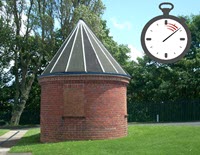 Not a great deal to tell, the college has the estimate of the work involved, the methods of how this will be tackled has been somewhat amended since the last update.
Not a great deal to tell, the college has the estimate of the work involved, the methods of how this will be tackled has been somewhat amended since the last update.
The felting on the roof etc may have to be removed after all as it has ‘bubbled’ in places, and a stable surface is required for the fibre glass to adhere to. It is hoped work will commence sometime in June. We will keep you informed.
Sky Notes
In this month's Sky Notes:
Planetary Skylights
Evening Planets

 Mars finally departs our evening sky towards the end of the month, but has one last encounter before being engulfed by twilight. This involves Mercury, also visible low in the WNW throughout much of June.
Mars finally departs our evening sky towards the end of the month, but has one last encounter before being engulfed by twilight. This involves Mercury, also visible low in the WNW throughout much of June.
Mars and Mecury, with The Moon at the beginning of the month, and
by themselves mid-month. Click for full-sized images.
To start with, look for Mercury at the beginning of the month when at its brightest (Mag. -1.0). Given a clear evening and unobstructed WNW views, with a little scrutiny Mercury should be readily visible no higher than a binocular field above the horizon around 45 minutes after sunset. (22:15h).
Mars will be descending down to meet Mercury with the two being in conjunction on the 18th and separated by less than half a degree. Of the two Mercury will still be the most obvious, with ‘ruddy’ Mars just below it. Use binoculars to help pick them out of the twilight around 22:20h before trying with just the naked eye. On the 4th a very slim crescent Moon lies lower left of Mercury and a day later to the left of Mars.

Mighty Jupiter reaches opposition on June 10th, visible all night (what little there is) rising as the sun sets. At Magnitude – 2.6, Jupiter will be very prominent, but is unfortunately well south of the ecliptic and therefore rather low down to the southeast/south horizon. To the observer Jupiter always offers up something of interest to view in the eyepiece, especially around opposition time. For a start it exhibits a disc size of over 46 arc seconds, resembling a bright sixpence with banding across it- even through small instruments.
Residing on the south equatorial belt is the huge ‘storm like’ feature known as the great red spot. Over the last few decades the GRS seems to have shrunk in size, but is still well in excess of Earth’s diameter. Because of the rapid rotation of Jupiter (10hrs approx) it is not always on view, (see times and dates below). When facing in our direction the GRS resembles a pale oval, more subtle in appearance than it used to be. The most dynamic aspect of the Jovian system, the four Galilean moons, are certainly fascinating to follow, throwing up a different configuration each night, even over the course of an hour or so, the relative change in position can be noticed. The Moon lies nearby on the 16th.
Jupiter Galilean moon shadow transits:
- Ganymede: 5th: 00:35-02:55h
- Europa: 8th: midnight-02:25h
Io; 20th/21st: 23:50-02:00h.
The Great Red Spot (GRS):
- Visible on the disk on the following dates: 1st -4th, 6th/7th, 9th- 11th, 14th -16th 19th-23rd, 26th-28th and the 30th.
- The GRS is already on the disk on the 11th and 23rd at 22:20h. Most of the rest are post midnight transits.
 Saturn follows Jupiter over the SE horizon a few hours later, making it a post midnight object for a little while yet and therefore observer unfriendly- unless you are a real night owl. Although not as brilliant as Jupiter, Saturn is nevertheless quite prominent to the naked eye, and like Jupiter it too resides well south of the ecliptic, left of the ‘teapot’ asterism in Sagittarius. Observations are again going to be somewhat compromised due to our atmosphere, but during moments of clarity Saturn is a gorgeous spectacle to observe The Moon lies nearby on the 23rd.
Saturn follows Jupiter over the SE horizon a few hours later, making it a post midnight object for a little while yet and therefore observer unfriendly- unless you are a real night owl. Although not as brilliant as Jupiter, Saturn is nevertheless quite prominent to the naked eye, and like Jupiter it too resides well south of the ecliptic, left of the ‘teapot’ asterism in Sagittarius. Observations are again going to be somewhat compromised due to our atmosphere, but during moments of clarity Saturn is a gorgeous spectacle to observe The Moon lies nearby on the 23rd.
Meteors

If you are a very early riser, look out for some shooting stars around May 5th-7th, when the eta Aquarid meteor shower reaches a peak. The actual peak falls on the 6th. This is one of two meteor showers associated with debris particles deposited over time by comet Halley, the other shower being the Orionids seen in late October.
Eta Aquarids have a ZHR (zenith hourly rate) approaching 30, but with Aquarius only just rising in the SE shortly before dawn, observations from the UK are always somewhat restricted. The radiant of the shower lies close to eta Aquarius, one of the stars making up the "water jar" in the otherwise faint constellation of Aquarius. View around 4am to the south and east.
The Summer Solstice and Noctilucent Cloud
The summer solstice in the northern hemisphere falls on June 21st, when the Sun reaches its greatest altitude in the sky on the ecliptic; the path it takes across the sky during a year.
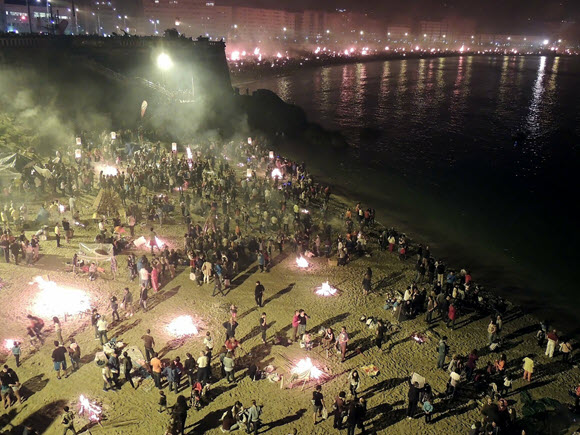
On Sun 23-Jun-2019, 2 days after The Summer Solstice, Spain Celebrates San Juan Day
with beach bonfires. Taken Jul-2014 by Jose Cernadas.
It is surprising how many people wrongly assume that Earth is closer to the Sun at this time of year; in fact the opposite is true. Earth is actually furthest from the Sun on July 4th at almost 95 million miles (153m km), nearly 3m miles (4½ m km) more than when at its closest approach in early January. It is the inclination of the northern hemisphere towards the Sun which causes days to ‘grow longer’ and feel warmer due to the higher concentration of sunlight per unit area. Think of this as being like a spot light directed onto to the palm of your hand, your palm feels hotter under direct radiation, whereas when the light is tilted, the angle reduces the heat intensity. The actual intensity of solar radiation in June is equivalent to approximately 1.2KW of heat for each square metre, although sometimes it feels as if someone’s forgotten to feed the meter.
Although known as the longest day, earliest sunrise and latest sunset times do not occur on the summer solstice date. Earliest sunrise falls around June 16th (from Whitby: 04:25h) whilst latest sunset occurs on June 25th (Whitby: 21:42h). It is the duration of useable daylight which reaches a maximum on the 21st, at just over 17 hours, with a meagre 4 hours of semi darkness.
Noctilucent cloud
With bright twilight persisting well into the night, throughout June and into the July, watch out for the beautiful type of cloud formation seen only at this time of year known as Noctilucent cloud.
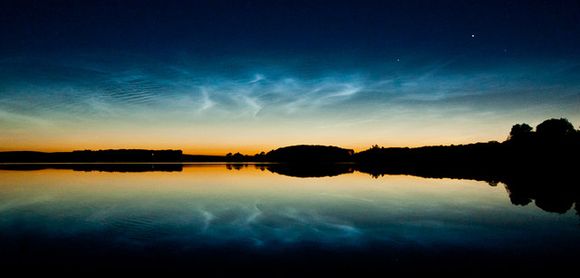
Noctilucent cloud formation, Mochrum Loch. Taken Jul-2011 by David Baird.
These delicate formations appear above the northern horizon, long after sunset, often around midnight. Shining quite brightly, Noctilucent cloud is filamentary in structure, having a characteristic silvery-blue colour. It forms almost exclusively between latitudes 50 and 60 degrees north, high in the upper atmosphere: 50 miles (80km) up five times higher than normal clouds.
It is thought that this type of cloud forms when water vapour condenses at the low temperatures that prevail at such altitudes onto particles suspended in the air. More frequent sightings of Noctilucent cloud over the last half century may indicate that these particles could be a result of industrial pollution, perhaps from increased air traffic. Do keep watch!
June 2019 Sky Charts
|
Looking North
Mid-June - 23:00h |
Looking South |
|
Looking East
Mid-June - 23:00h |
Looking West
Mid-June - 23:00h |
|
Northern Aspect
Mid-June - 23:00h |
Southern Aspect
Mid-June - 23:00h |
| Looking North (Early) Mid-June - 03:05h |
Looking South (Early) Mid-June - 03:00h |
Additional Image Credits:
- Planets and Comets where not otherwise mentioned: NASA
- Sky Charts: Stellarium Software
In-Focus
Next month sees the 50th anniversary of the first Moon landing, which I shall be covering in greater detail in July’s notes, but for this month I thought perhaps to take a look at The Moon from an observing standpoint, especially as June ‘nights’ are so short.

Situated around 240,000 miles (386,000km) away, our near neighbour is often overlooked by observers, especially when near full... a pity as it is a wonderful object to explore as it waxes and wanes, even observable well before the sunset. At some 2,160 miles (3,476km) in diameter, roughly a quarter the size of Earth, the fifth largest satellite in the solar system is best appreciated when viewed through a telescope, a very modest one will suffice. Many features such as the dark Maria (or “lunar seas”) can be distinguished easily through binoculars, even with the naked eye you can follow the appearance of these regions as The Moon changes phase. These less ‘ancient’ areas of The Moon formed when lava flooded lower lying regions of the lunar surface between 3 billion and 3.8bn years ago. The heavily cratered highland areas’ are the most ancient, up to 4.4bn years old.
We can begin our lunar watch from near the start of June, following the terminator; the border between day and night, marching across the lunar surface, transforming its appearance with almost magical spectacle as it does so. The Moon is new on the 3rd so start observing on the 6th or 7th, by which time the isolated dark circular patch of Mare Crisium (the Sea of Crises) as well as Mare Fecunditatis (Sea of Fertility), are already visible. Prominent craters visible include Cleomedes, Langrenus and Petarvius, all of which are around 100 miles in diameter, whilst further north on the lunar surface, look for the striking crater pair of Atlas and Hercules close to the terminator.
By June 9th the observers’ eye is drawn towards Mare Nectaris (Sea of Nectar) and the splendid crater trio of Theophilus, Cyrillus and Catharina. Theophilus is the best defined of the three and overlaps Cyrillus and therefore must be the youngest. The following evening The Moon reaches First Quarter when it appears half phase. To the naked eye the most striking aspect are the four interconnected seas that resemble a “claw” formation. The actual “pincers” of the claw are comprised of two seas; Mare Foecunditatis (the Sea of Fertility) and Mare Nectaris. Adjoining both is Mare Tranquillitatis (the Sea of Tranquility), the location where “just one small step” focused the world’s attention on the “giant leap” mankind was making back in July 1969. The large circular sea of Mare Serenitatis (Sea of Serenity) butts up to Tranquility.
Around the 8th day after New, the advancing sun’s rays uncover some of The Moons most spectacular features. Note the large dark mass of Mare Imbrium (the Sea of Showers), bounded to the North and East by the vast mountain chains of the lunar Alps and Apennines. Look in particular for the dark floored ringed plains of Plato and Archimedes as well as the Alpine Valley an 80 mile (128km) long gash that cuts through the lunar Alps. The following evening one of The Moon’s largest and most majestic formations the 140 mile (225km) diameter walled plain Clavius (the only crater directly visible to the naked eye), emerges to prominence. Across its floor an arc of ‘smaller’ craters sweep, initially resembling inky wells until sunlight penetrates their shadowy depths. By June 13th the spectacular crater Copernicus takes center stage, some 54 miles (87km) in diameter and almost 4 miles (6½km) deep with a fine central peak. My personal favourite crater, Eratosthenes, lies close by at the terminus of the rugged Apennine Mountain range. Yet another stunning vista awaits 24 hrs later, when the first gleams of sunlight catch the pinnacles of the Jura Mountains forming the northern perimeter of the dark floored Sinus Iridum (Bay of Rainbows).
The Moon is now gibbous with the great dark expanse of Oceanus Procellarum (Ocean of Storms) slowly becoming uncovered, along with the smaller seas of Mare Nubium (Sea of Clouds) and Mare Humorum (Sea of Humours). When The Moon reaches full (June 17th) it lies opposite the Sun in the sky and when viewed its surface features appear washed out, indeed formations that looked so spectacular earlier in the lunar cycle are now rendered almost invisible by sunlight. Only around Full do the lunar rays; the bright ejecta streaks emanating from more recently formed impact craters such as Kepler, Copernicus and most conspicuous of all, Tycho, become prominent to the eye. The brightest of all lunar features, the crater Aristachus, is visible on Oceanus Procellarum and can even be glimpsed when The Moon is in earthshine. The darkest lunar feature, the flooded plain Grimaldi lies further south near the lunar limb. As The Moon wanes, you can then watch the whole magical process in reverse, and marvel how it all looks so different.
So, find a pair of binoculars, or better still a small scope, and take a good look at our travelling companion in space – a whole world just waiting to be explored!
Events
 Observe the night sky with us at the Bruce Observatory, Whitby School
Observe the night sky with us at the Bruce Observatory, Whitby School
Observing Nights are held weather permitting: check for a relatively clear sky before leaving home. If in doubt, Mark can be reached on 07886069339
Please note the college drive gate is now operated via a electronic key code - so anyone wishing to attend must be at the car park at the top of the drive by 19:00hrs - unless an arrival time has been arranged with Mark/Keith.
 Whitby School - Room H1.
Whitby School - Room H1.
In Members' monthly meetings we usually take a tour of the night sky for the coming month using the Planetarium program. Have talks and presentations on various topics of astronomy/space etc, and discuss future events etc. New members welcome.

